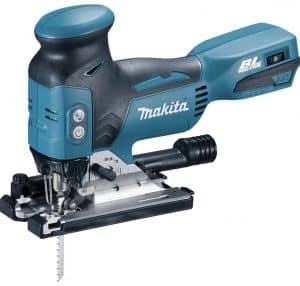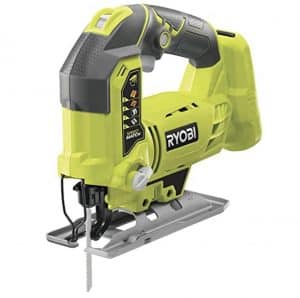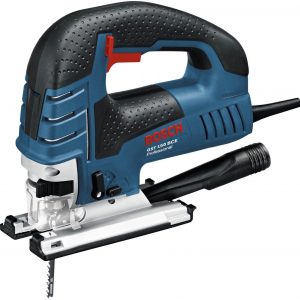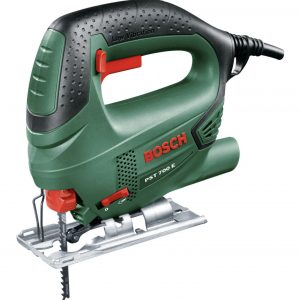There’s nothing better than retreating to your own workshop and focusing on your woodworking hobby. At least, that’s how I feel. One tool that is an absolute staple for me is the famous, durable jigsaw.
Any serious woodworker will have a jigsaw in their inventory. It’s a powerful tool that can cut through wood surfaces like butter. My DeWalt certainly does that, alongside my old Makita, who is still a trusty companion these days.
Finding the best jigsaws for woodworking and the right one to suit your needs can be difficult. Thankfully, I have you covered. I will go through my 5 top picks for the best jigsaw tools available.
Best Jigsaws For Woodworking: At A Glance
Why Take My Word For It?
As an avid woodworker, I’m constantly testing new tools, seeking the best results to aid my growing hobby. A jigsaw is a woodworker’s best friend, so it’s important to have one that can do the job.
I have reviewed the 5 jigsaws below, putting them through their paces on my various home projects throughout the years. Without fluff, I will discuss the good and the not-so-good so you can decide on your next jigsaw.
As I said, a jigsaw is a crucial tool for woodworking, so it’s important to get it right. I’ve found the 5 best jigsaws for woodworking, and they can do any job.
The 5 Best Jigsaws For Woodworking
All of these jigsaws have the ability to complement your woodworking skills. Here’s why.

- Powerful 18V battery for tackling tough jobs – compatible with all DeWalt 18V and 54V batteries
- Impressive 135 mm cutting capacity in wood – also handles aluminium up to 25 mm
- Brushless motor maximises runtime and efficiency – less maintenance, more work done
- Tool-free blade changes for quick swaps on-site – save time and hassle between cuts
- Dual LEDs and dust blower for clear, clean cutting – improved visibility and less mess
- Weight - 2.1KG
- Cutting Capacity - 135mm
- Voltage - 18V
- Brushless Motor - Yes
- Dad Satisfaction - 10/10
What's Good?
- Adjustable speed control
- Quick and easy blade changes
- Bevel cutting capability (0-45 degrees)
What Could Be Better?
- Poor straight-cutting performance without a guide
I’ve been using the DeWalt DCS334 cordless jigsaw as my staple jigsaw for a few years, and it’s still an indispensable tool in my workshop.
The speed control dial on top allows me to adjust the blade speed when preparing my cuts on different materials—higher for softwoods and lower for dense hardwoods, which helps prevent blade burnout. With its lock feature, the variable control trigger provides even more speed control during cuts.
The blade release latch is an awesome feature that makes blade changes easy; it’s a real time saver when switching between different tasks. While I haven’t found much use for the finger guard or orbital action lever personally, I see how they might be beneficial.
The shoe bevel lever is a brilliant addition. It enables angled cuts between 0 and 45 degrees, effectively mimicking a mitre saw. It’s worth noting that straight cuts can be a bit challenging without a guide, and I’ve had to devise my own solutions for achieving perfectly straight lines.
Despite this minor drawback, the jigsaw excels at curve cutting and offers impressive speed and precision. I have a host of other DeWalt tools, so being able to swap the batteries is a massive plus, streamlining my tool collection.
I can genuinely say that this jigsaw has been a reliable workhorse. I’d recommend it to both DIY enthusiasts and professionals. I think including a built-in guide system for straighter cuts in future models would make this already excellent tool even better.

- Pioneering cordless jigsaw with Li-ion battery – first of its kind for enhanced portability
- Powerful brushless motor – delivers 800-3,500 strokes per minute for efficient cutting
- Versatile cutting capacity – handles up to 135 mm in wood, 20 mm in aluminium, and 10 mm in steel
- Advanced dust management – improved dust extraction hose joint and built-in blower function
- Precision control features – variable speed dial, 3 orbital settings, and ‘soft no load’ function for reduced vibration
- Weight - 3KG
- Cutting Capacity - 135mm
- Voltage - 18V
- Brushless Motor - Yes
- Dad Satisfaction - 10/10
What's Good?
- Easy to use upside down, making it ideal for coping cuts
- Better control when turning corners due to a lower centre of gravity
- Quick and easy base plate changes with built-in Allen key storage
What Could Be Better?
- The soft start feature can be annoying, especially when making fine cuts
The Makita barrel grip cordless jigsaw is also one of the best saws in my toolkit, and I’m still impressed with its performance.
The barrel grip design offers strong control, particularly when making intricate cuts or working upside down for coping.
The tool’s versatility is great, especially with the easy-to-switch base plates – swapping between standard and coping plates is nice and easy, thanks to the conveniently stored Allen key.
The lower centre of gravity makes cornering natural, giving me great control over my cuts. The soft start feature took some getting used to; it can be a tad jarring when you’re about to make a fine cut.
Despite this, the jigsaw’s overall performance is still top-notch. Its ability to handle complex cuts significantly improves my workflow, especially on projects like deck-building.
The build quality is solid, living up to Makita’s reputation for durability. I’ve had this jigsaw for a while, and it’s held up remarkably.
I recommend giving this Makita barrel grip a go. Just be prepared for a slight learning curve with the soft start feature, and you’ll be rewarded with a tool that can handle a wide range of carpentry tasks, like a knife through butter.

- Impressive 25mm stroke length – cut through 101mm of wood or 6mm of steel with ease
- Versatile bevel cuts – adjustable aluminium base tilts up to 45° for precise angled cutting
- Fatigue-reducing lock-on switch – maintain continuous cutting without constant finger pressure
- Part of the 18V ONE+ system – compatible with all batteries in the range for ultimate flexibility
- Customisable cutting action – 4 pendulum settings and variable speed (1100-3000 strokes/min) for optimal results in various materials
- Weight - 2.1KG
- Cutting Capacity - 135mm
- Voltage - 18V
- Brushless Motor - No
- Dad Satisfaction - 9/10
What's Good?
- Versatile orbital adjustment with 4 settings for different cutting needs
- Ability to make angled cuts from 15 to 45 degrees
- Cordless design for enhanced portability and ease of use
What Could Be Better?
- Lack of a dust blower and LED light, which would improve visibility during cuts
I was thoroughly impressed with its performance after using the Ryobi One+ 18V Cordless Jigsaw (RGS 18-0). The jigsaw tool’s user-friendly design shines through, with a hassle-free blade insertion system that clicks into place.
The orbital adjustment knob offers four settings from 0 to 3. It provides excellent control over cut aggressiveness, allowing for both close-quarter cutting and rough cuts with ease.
I loved the jigsaw’s ability to make angled cuts up to 45 degrees, adding another functionality layer. It’s cordless and convenient, and the compatibility with various blade types for cutting wood, metal, plastic, and even tiles makes it a true all-rounder.
Its lightweight design is a definite plus, as you can use it for longer periods without stopping because of an aching arm.
While the Ryobi jigsaw ticked many boxes, I did notice that the battery life could be better. However, my battery wasn’t brand new, so it could be down to that.
Some might also find the lack of a dust blower or LED work light slightly disappointing. Simple features like that can really enhance the tool. Overall, the Ryobi One+ 18V Cordless Jigsaw is a solid, versatile tool that offers great value for money.

- Powerful 780-watt motor – tackles hard and thick beams with ease, even under heavy loads
- Exceptional cutting depth – slices through 150mm of wood, 20mm of aluminium, or 10mm of steel
- Precision-engineered blade system – new clamping design ensures accurate cuts and tool-free changes
- Customisable cutting action – 4-stage pendulum stroke and variable speed (500-3,100 spm) for optimal results
- User-friendly design – ergonomic grip with softgrip surfaces and Bosch SDS System for enhanced comfort and control
- Weight - 4.5KG
- Cutting Capacity - 150mm
- Voltage - 240V
- Brushless Motor - No
- Dad Satisfaction - 9/10
What's Good?
- Impressive 150mm cut capacity, suitable for large timber jobs
- Variable speed control on both dial and trigger for precise cutting
- SDS blade change system for quick and safe blade swaps
What Could Be Better?
- Corded design can obviously limit mobility compared to the cordless alternatives
I’ve recently had the pleasure of putting the Bosch GST150 BCE bow-handled professional jigsaw through its paces, and I must say, for a corded jigsaw, it thoroughly impressed me. This powerhouse boasts a generous 4-metre cable, eliminating the need for extension leads in most situations.
The standout feature is undoubtedly its remarkable 150mm cut capacity, which opens up a world of possibilities for tackling hefty timber jobs.
The variable speed control on the dial and trigger offered unparalleled precision across different materials. The 780-watt motor, coupled with constant electronics, gave me a consistent performance even when the going got tough.
The SDS blade change system is a godsend, allowing quick and safe blade swaps without the risk of singed fingers.
While the dust extraction capabilities are good, the plastic visor is a tad flimsy and potentially prone to damage when adequately put through its paces.
The three-stage pendulum action is perfect for speedy cuts through thicker materials. However, I noticed a slight cut quality trade-off at higher settings.
It also has a three-year warranty (remember to register online!). Overall, this jigsaw represents excellent value for money and is a worthy addition to any serious DIYer’s toolkit.

- Compact powerhouse – 500W motor cuts 70mm in wood and 4mm in steel, despite weighing only 1.7kg
- Precision control – Bosch Electronic enables material-specific stroke rate adjustment via the trigger switch
- Smooth operation – ‘Low Vibration’ technology with linear mass balance for comfortable, precise cutting
- Quick blade changes – Bosch SDS system allows tool-free blade swaps in seconds for enhanced efficiency
- Clear cutting line – switchable air blast function and dust extraction port ensure optimal visibility and cleanliness
- Weight - 1.7KG
- Cutting Capacity - 70mm
- Voltage - 240V
- Brushless Motor - No
- Dad Satisfaction - 8/10
What's Good?
- SDS mechanism for quick and easy blade changes
- Adjustable baseplate allowing cuts from 0 to 45 degrees in both directions
- Low vibration handle for comfortable use
What Could Be Better?
- Only one jigsaw blade is included in the package
At such a great price, I couldn’t help but buy the Bosch BST 700, a 500-watt jigsaw that is an excellent piece of kit. Its user-friendly design and comfortable grip immediately impress, featuring a low-vibration handle that ensures steady control throughout use.
The SDS mechanism for quick blade changes allows for effortless swaps without additional tools.
An adjustable baseplate can be set at angles from 0 to 45 degrees in both directions. The dust extraction port is an important inclusion, though it could be more effective with finer sawdust.
While the 500-watt motor provides ample power for most cutting tasks, it struggled slightly with thicker hardwoods, which might be a consideration for your more demanding projects.
The inclusion of only one blade in the package feels a bit stingy, especially given the wide range of Bosch blades available. However, the three-year manufacturer’s guarantee (again, remember to register online!) adds a layer of confidence to the purchase.
The Bosch BST 700 is a solid choice for someone seeking a reliable, versatile jigsaw for their projects at a great price.
A Buying Guide
Power
Corded jigsaws are usually measured in watts ranging from 400 to 900. Meanwhile, the cordless ones have about the same number of strokes per minute (ppm) as a powerful motor.
An optimal jigsaw with a stroke rate of around 3,000 per minute is where the magic happens.
Orbital Cutting Action
Some jigsaws take it further using an orbital cutting action, in which the blade moves forward while cutting straight lines.
The best jigsaws for woodworking do not require much pressure from you; the jigsaw glides with a comfortable grip while they easily handle materials with no sweat required.
Its superior engineering ensures the blade remains rock-solid while cutting in two directions.
Speed
Speed relies on variable speed triggers and powerful motors. It all comes down to pressure management. Jigsaws usually have two-speed options.
You need to apply just the right amount of pressure to the trigger or locate a dedicated switch that manages speed control for you.
Blades
The right blade is essential for slicing through wood and metal. Different materials require different blades.
T-shank blades are the main blades you want to look out for. With twin protrusions at the far end of the cutting edge to identify them.
Curve Control
Jigsaws are more than just straight lines. Curve control is key to the art of long cuts. They usually span up to 45-degree incisions with adjustable bases.
Corded & Cordless
Jigsaws come in two primary flavours: corded and cordless. A corded jigsaw might be your best bet if you want steady, reliable power and are okay with being tethered to an outlet. Cordless jigsaws offer the freedom to work anywhere without tripping over cords.
They’re perfect for job sites or projects where you must move around often. When choosing cordless models, remember to consider battery life, how long it takes to recharge, and the voltage. Each type has pros, so it comes down to how and where you plan to use your jigsaw.
Grip
Jigsaw often generates friction and heat. A rubberised handle can make all the difference with a hand grip. Get a soft-grip jigsaw to keep your hand comfortable and firmly in place.
Depth
The cutting depth of your jigsaw can have a different impact on your project depending on which jigsaw you choose. When working with metal, the cutting depth is usually less than that of a wood-cutting jigsaw.
The best jigsaws for woodworking provide nearly twice the timber cutting depth of 70mm found in lower-priced models.
Light & Laser Guidance
If your workshop receives little natural light, a jigsaw with a laser guide and LED light is a great solution.
An LED light will help illuminate your cutting area, while a good, bright laser line will help you follow straight, neat lines. Your curved cuts, however, defeat the object.
Dust Blower
Jigsaws produce dust, which usually settles directly ahead of the blade in the cutting area. Therefore, using a dust blower to blow it away is useful. Unfortunately, even the best jigsaws lack the common vacuum cleaner-style dust collector on sanders.

Jigsaws And Their Blades
When examining a jigsaw blade, you’ll notice its similarity to a traditional hand saw blade rather than a circular saw blade. This blade type is renowned for its deliberate back-and-forth motion, allowing for efficient wood cutting.
The blade’s performance determines how smoothly and effectively it can slice through materials.
Blade Quantity
The number of blades in a set is an important consideration. A set can have 10 or a bit higher, like 50 or 40. Although the blade count doesn’t directly affect cutting efficiency, it impacts the set’s versatility. More blades mean greater flexibility for various tasks.
Blade Teeth
The rating of jigsaw blades is based on their teeth per inch (TPI). A higher rating indicates more teeth on the blade. Typically, you’ll find blades with 30 or 20 TPI. More teeth provide better performance as they cut through materials more effectively.
Carrying Case
Many jigsaw blades come neatly arranged in carrying cases, which is handy for storage and transportation. A carrying case is also ideal for safety since sharp saw blades can be dangerous. A proper case can also help protect the blades from rust and dust.
Blade Material
The material jigsaw blades are made of plays a significant role in how tough and good they are. You’ve got a few options: bi-metal, high-speed steel, carbide, and high-carbon steel. Each one’s got its strong points:
Carbide blades are your go-to for cutting things besides wood, like stainless steel, tile, or glass.
High-carbon steel blades are great at slicing through soft materials like softwood, soft plastic, or fiberboard.
High-speed steel blades are built to handle non-ferrous metals like copper and aluminium. They stand up really well to wear and tear.
Bi-metal blades combine high-speed and carbon steel to last a long time and cut through hard metals without breaking a sweat.
Blade Length
Saw blades come in various lengths. Longer blades allow for deeper cuts but are more prone to bending. However, due to the increased cutting surface, you can still achieve excellent results with a longer blade with a low TPI.
Blade Width
Similar to blade length, blade width varies, typically 3/8 inch or ¼ inch. A wider 3/8-inch blade is ideal for cutting gradual curves, while a thin ¼-inch blade is perfect for tighter curves. The best blade width depends on the specific requirements of your project.
Tooth Direction
Jigsaw blades can have teeth pointing either upwards or downwards. Blades with standard tooth direction (pointing upwards) cut on the upstroke, resulting in splintering on the top of the board and tear-out on the back.
Blades with a reverse tooth direction (pointing downwards) cut on the downstroke, eliminating the need to flip the board.
Blade Shanks
There are three types of shanks: T-shank, Bayonet shank, and U-shank. Bayonet shanks are no longer commonly used; if you have one, it’s time to replace it. U-shanks, which require tools for blade changes, have also become outdated, but blades made with this type are relatively budget-friendly.
Today’s best jigsaw blades utilise the T-shank design, which has become a favourite among users. The tiny wings on T-shank blades hold them securely in place and offer a comfortable grip. The best part is that changing T-shank blades is as simple as pushing a button.
The best jigsaws for woodworking typically offer variable speed control, orbital action, and a sturdy baseplate. Top models like the Bosch GST150 BCE and DeWalt DCS334 provide excellent cut capacity and precision for various woodworking tasks.
Look for features such as tool-less blade changes, dust blowers, and ergonomic designs to enhance your woodworking experience.
When selecting the best jigsaw for woodworking, consider factors like power output, cutting capacity, and available features. For most woodworking tasks, a jigsaw with at least 500 watts of power and a cut capacity of 2-3 inches is ideal.
Look for models with variable speed control, pendulum action, and a robust blade clamping system. Cordless options offer greater mobility, while corded models provide consistent power for extended use.
Jigsaws excel at making curved and intricate cuts in various materials, including wood, plywood, MDF, and even thin metals or plastics. They’re ideal for cutting shapes, circles, and bevelled edges in woodworking projects.
While they can make straight cuts, they’re handy for tasks that require manoeuvrability and precision, such as cutting out sinkholes in countertops or creating decorative patterns in the wood.
The choice between a jigsaw and a reciprocating saw depends on your typical projects. Jigsaws are better for precision, curved cuts, and fine woodworking. They offer more control and cleaner cuts.
Unlike Bandsaws and Routers, reciprocating saws are more suited for demolition work, rough cuts, and cutting through multiple materials quickly. A jigsaw is the more versatile and precise option for most woodworking projects.
Choosing the right jigsaw blade depends on the material you’re cutting and the type of cut you want to achieve. Use blades with fewer, larger teeth for faster, rougher softwood cuts for woodworking.
Blades with finer teeth are better for smoother hardwood cuts or cutting curves. Always match the blade material to your workpiece – wood blades for wood, metal blades for metal, etc. Most blade packaging indicates the suitable materials and cut types.
When using a jigsaw, you should generally push it forward gently along your cutting line. Let the tool do the work – don’t force it. The blade cuts on the upstroke, so pushing allows the saw to clear sawdust effectively and maintain a clean cut line.
However, some advanced techniques for specific cuts may involve carefully pulling the saw. Always ensure the blade is moving before contacting the workpiece to prevent kickback.
An orbital jigsaw is a type of jigsaw that offers an additional cutting motion. While a standard jigsaw blade moves only up and down, an orbital jigsaw blade moves in a slight elliptical pattern.
This orbital action allows for more aggressive cutting, especially in wood, resulting in faster cuts. Most modern jigsaws, mainly those considered the best for woodworking, include adjustable orbital action, allowing you to switch between straight and orbital cutting depending on your needs.
5 Sublime Jigsaws For Woodworking
Thanks for reading our article on 5 Sublime Jigsaws For Woodworking. Please go check out our blog HERE for more advice for those handy dads out there.






